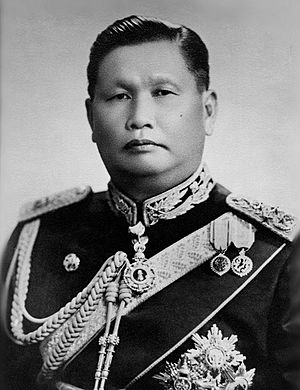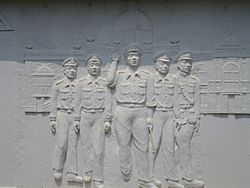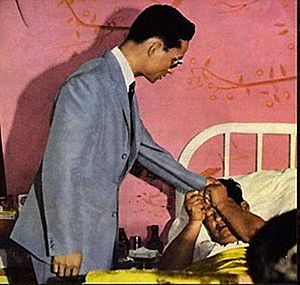Sarit Thanarat facts for kids
Quick facts for kids
Sarit Thanarat
NR PChW SR MPCh MWM OMRI LOM KmstkSO GCA GCS
|
|
|---|---|
|
สฤษดิ์ ธนะรัชต์
|
|

Thanarat in 1962
|
|
| 11th Prime Minister of Thailand | |
| In office 9 February 1959 – 8 December 1963 |
|
| Monarch | Bhumibol Adulyadej |
| Deputy |
See list
Thanom Kittikachorn
Prince Wan Waithayakon |
| Preceded by | Thanom Kittikachorn |
| Succeeded by | Thanom Kittikachorn |
| Minister of Defence | |
| In office 31 March 1957 – 12 September 1957 |
|
| Prime Minister | Plaek Phibunsongkhram |
| Preceded by | Plaek Phibunsongkhram |
| Succeeded by | Thanom Kittikachorn |
| Supreme Commander of the Armed Forces | |
| In office 27 September 1957 – 8 December 1963 |
|
| Preceded by | Plaek Phibunsongkhram |
| Succeeded by | Thanom Kittikachorn |
| Commander in Chief of the Royal Thai Army | |
| In office 23 June 1954 – 8 December 1963 |
|
| Preceded by | Phin Choonhavan |
| Succeeded by | Thanom Kittikachorn |
| Minister of National Development | |
| In office 9 February 1959 – 8 December 1963 |
|
| Prime Minister | Himself |
| Preceded by | Office established |
| Succeeded by | Sahorda Weerathien |
| Commissioner-General of the Royal Thai Police | |
| In office 9 February 1959 – 8 December 1963 |
|
| Preceded by | Sawai Saenyakorn |
| Succeeded by | Prasert Ruchirawongse |
| Personal details | |
| Born | 16 June 1908 Bangkok, Krung Thep, Siam (now Phra Nakhon, Bangkok, Thailand) |
| Died | 8 December 1963 (aged 55) Phramongkutklao Hospital, Phaya Thai, Bangkok, Thailand (now Ratchathewi, Bangkok, Thailand) |
| Spouse | 4 (81 mistress) |
| Children | 7 (1 adopted) |
| Profession | |
| Signature | |
| Military service | |
| Allegiance | Thailand |
| Branch/service | Royal Thai Army Royal Thai Navy(honorary) Royal Thai Air Force(honorary) Royal Thai Police Volunteer Defense Corps Royal Thai Armed Forces |
| Years of service | 1928 - 1963 |
| Rank | Field Marshal Admiral of the Fleet Marshal of the Air Force Police General VDC Gen. |
| Commands |
|
| Battles/wars | Boworadet rebellion Japanese conquest of Burma Vietnam war |
Field Marshal Sarit Thanarat (also called Dhanarajata; Thai: สฤษดิ์ ธนะรัชต์, pronounced [sā.rìt tʰā.ná.rát]; 16 June 1908 – 8 December 1963) was a Thai general. He led a coup d'état in 1957. After the coup, he became Thailand's prime minister. He served in this role until he passed away in 1963. Sarit was born in Bangkok. However, he spent his childhood in northeastern Thailand. His father, Major Luang Ruangdetanan, was an army officer. He was known for translating Cambodian stories into Thai.
Contents
Sarit's Military Career
Sarit Thanarat went to a monastery school. In 1919, he joined the Chulachomklao Royal Military Academy. He finished his military training in 1928. He then became a second lieutenant. During World War II, he commanded an infantry group. He helped invade and occupy the Shan States in Burma.
After the war, Sarit was promoted. He commanded the 1st Infantry Regiment in Bangkok. As a colonel, he played a key part in the 1947 military coup. This coup removed Prime Minister Thawal Thamrong Navaswadhi. It brought back Luang Phibunsongkram as prime minister. Sarit then became very interested in politics. In 1954, he became the Commander of the Royal Thai Army.
How Sarit Became Prime Minister
In the early 1950s, the government led by Phibun became less popular. This created a chance for Field Marshal Sarit Thanarat to rise to power.
Elections of 1957
In 1955, a new law allowed many political parties to form. The government's party was called Seri Manangkhasila. Phibun was its leader, and Sarit was his deputy.
Even though Seri Manangkhasila won the election, many people felt the Democrat Party had won fairly. People and newspapers said the government cheated. They also claimed the government used violence against voters. To stop public anger, Phibun declared a state of emergency. Sarit was made the supreme commander of the military. However, Sarit distanced himself from the unfair election. He said the 1957 elections were "dirty, the dirtiest. Everybody cheated."
The Isan Drought
In 1957, the Isan region of Thailand faced a severe drought. Many people from the northeast moved to Bangkok. This caused social problems in the city. The government seemed to ignore the issue. They said it was normal for people to move and eat frogs and lizards. Students and monks set up help stations at the train station. They helped the many refugees arriving daily.
The Minister of Agriculture said there was no crisis. He flew over the region and reported that everything was fine. Later, the government gave 53 million baht to the 53 Isan representatives. This was an attempt to solve the problem.
The Coup of 1957
On September 13, 1957, Sarit gave Phibun the army's demands. The demands, signed by 58 army officers, asked the government to resign. The public supported Sarit's demands.
On September 15, a large crowd gathered to protest Phibun. They marched to Sarit's home to show support for the army. Sarit was not home, so the crowd went to the government building. There, they gave speeches against the government. Later, they returned to Sarit's home. He spoke to them, saying he acted for the people. He said their support gave him strength to continue.
The next morning, Sarit and his army carried out a coup d'etat. This means they took control of the government by force. In less than an hour, the army took over important places without any fighting. Sarit's soldiers wore white armbands to show their pure intentions. After this, Phibun quickly left the country. This marked the beginning of Sarit's time in power.
Sarit's Leadership Style
Many experts say that the Cold War helped Sarit's government stay in power. Sarit made sure Thailand's foreign policy was against communism. This helped Thailand receive money and military aid from the United States. The U.S. believed that only the Thai military could stop communism.
Sarit's leadership style was also influenced by old Thai ideas. These included phokhun (patriarchal rule) from the Sukhothai Kingdom. This means a leader acts like a kind father to his people. He also used ideas from the Ayutthaya Kingdom about a powerful ruler. Sarit combined these ideas to create his own way of leading.
Sarit's Time as Prime Minister
Helping the People
Soon after the coup, Sarit made changes to help ordinary people. Electricity prices were lowered. Families in Bangkok who didn't have much water received free water. The government also removed some taxes and fees. Hospitals were told to give free medicine to the poor. Nurses and social workers visited homes to help with health issues.
To lower food prices, Sarit opened new markets. Merchants could sell goods directly to people, cutting out middlemen. This helped reduce prices. Sarit even lowered the price of iced black coffee, a popular drink. These actions helped create excitement for the new government.
Keeping Order
Sarit said Thailand would follow the UN's Universal Declaration on Human Rights. However, he also said there would be exceptions.
Sarit used Article 17 of the Interim Constitution to order executions. This article gave him a lot of power. Under his rule, parliament was removed. Newspapers were heavily controlled. Political parties were banned. People suspected of working with communists were put in prison. From 1958 to 1963, eleven people were executed using this power. Many people who were imprisoned were not communists. They were writers or thinkers who disagreed with Sarit. About 1,000 people were arrested under this rule.
Sarit's government was very strict. Some people saw his strict rule as a modern version of the phokhun style. In this view, a kind leader steps in to help his people.
The Monarchy Under Sarit

Under Sarit's leadership, the monarchy became very important again. Sarit encouraged King Bhumibhol Adulyadej to attend public events. The King visited different provinces and supported development projects. He also gave diplomas to university graduates. These actions helped bring the monarchy closer to the people. They also made the King more respected. An old tradition of bowing low before the King, which was stopped years ago, was brought back.
Sarit's government also brought back traditional festivals. These ceremonies had been stopped after the 1932 revolution. An example is the Royal Ploughing Ceremony, which is very old.
Sarit's government wanted to strengthen the monarchy for two main reasons. First, the monarchy gave his government and its policies more legitimacy. The King supported Sarit's plan to take power. Second, the monarchy helped with the government's programs for the people. The King's role was like a charity. He collected money from private donors. This money was used for public programs. This helped both the government and the monarchy look good.
Over time, the King made more public appearances. He also had more meetings with the prime minister and other government officials. The monarchy and the military also grew closer.
Sarit's Death
Sarit passed away suddenly in late 1963. He died from liver failure. His economic plans were starting to work well. After his death, power was smoothly passed to his deputies. Thanom Kittikachorn became prime minister. Praphas Charusathien became deputy prime minister. They continued Sarit's strict government style. They also kept his anti-communism and pro-U.S. policies.
Sarit had a strong relationship with King Bhumibol. The King ordered 21 days of official mourning in the palace. Sarit's body lay in state for 100 days. The King and Queen attended his cremation in March 1964.
Images for kids
Royal Decorations
Like many senior Thai military officers and politicians, Sarit received many royal awards. These are part of the Honours System.
 Knight of The Ancient and Auspicious Order of the Nine Gems – 1959
Knight of The Ancient and Auspicious Order of the Nine Gems – 1959 Ribbon for the 1st Class of the Most Illustriou Order of Chula Chom Klao – 1959
Ribbon for the 1st Class of the Most Illustriou Order of Chula Chom Klao – 1959 Knight Grand Commander of the Honourable Order of Rama – 1962
Knight Grand Commander of the Honourable Order of Rama – 1962 Knight Grand Cordon (Special Class) of the Most Exalted Order of the White Elephant – 1952
Knight Grand Cordon (Special Class) of the Most Exalted Order of the White Elephant – 1952 Knight Grand Cordon (Special Class) of The Most Noble Order of the Crown of Thailand – 1951
Knight Grand Cordon (Special Class) of The Most Noble Order of the Crown of Thailand – 1951 Victory Medal – World War II – 1962
Victory Medal – World War II – 1962 Safeguarding the Constitution Medal – 1934 – for helping put down the Boworadet Rebellion
Safeguarding the Constitution Medal – 1934 – for helping put down the Boworadet Rebellion Border Service Medal – 1962
Border Service Medal – 1962 Chakra Mala Medal – 1942
Chakra Mala Medal – 1942 Boy Scout Citation Medal – 1962
Boy Scout Citation Medal – 1962 King Rama VIII Royal Cypher Medal, 2nd Class – 1950
King Rama VIII Royal Cypher Medal, 2nd Class – 1950 King Rama IX Royal Cypher Medal, 1st Class – 1958
King Rama IX Royal Cypher Medal, 1st Class – 1958
Foreign Honours
 Kingdom of Laos :
Kingdom of Laos :
 Cambodia :
Cambodia :
 Italy :
Italy :
 Grand Cross of the Order of Merit of the Italian Republic-1955
Grand Cross of the Order of Merit of the Italian Republic-1955
 Portugal :
Portugal :
 Germany :
Germany :
 Grand Cross 1st Class of the Order of Merit of the Federal Republic of Germany-1960
Grand Cross 1st Class of the Order of Merit of the Federal Republic of Germany-1960
 Spain :
Spain :
 Grand Cross with White Decoration of the Order of Military Merit-1961
Grand Cross with White Decoration of the Order of Military Merit-1961
 Brazil :
Brazil :
 Grand Cross of the Order of the Southern Cross-1961
Grand Cross of the Order of the Southern Cross-1961
 Netherlands :
Netherlands :
 Luxembourg :
Luxembourg :
 Belgium :
Belgium :
 Grand Cordon of the Order of Leopold-1961
Grand Cordon of the Order of Leopold-1961
 Japan :
Japan :
 Grand Cordon of the Order of the Rising Sun with Paulownia Flowers-1963
Grand Cordon of the Order of the Rising Sun with Paulownia Flowers-1963
 Sweden :
Sweden :
 Philippines :
Philippines :
 Taiwan :
Taiwan :
 Norway :
Norway :
 Kingdom of Greece :
Kingdom of Greece :
 Austria :
Austria :
 Gold Star with Sash of the Decoration of Honour for Services to the Republic of Austria
Gold Star with Sash of the Decoration of Honour for Services to the Republic of Austria
 Argentina :
Argentina :
 Pakistan :
Pakistan :
 South Korea :
South Korea :
 Indonesia :
Indonesia :
See also
 In Spanish: Sarit Thanarat para niños
In Spanish: Sarit Thanarat para niños
- List of prime ministers of Thailand
- Khao Yai National Park
- Khon Kaen University





